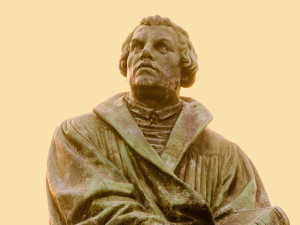by Dr. Jack Kilcrease
 Martin Luther died at 3:00 AM on February 18, 1546. Contrary to the expectations of Luther and many of his colleagues, he did not die in Wittenberg, the location of many of his greatest accomplishments. Rather, he passed away in Eisleben, the town of his birth. Two weeks prior, Luther had been called to Eisleben to mediate a dispute between two brothers who were both counts of Mansfeld.
Martin Luther died at 3:00 AM on February 18, 1546. Contrary to the expectations of Luther and many of his colleagues, he did not die in Wittenberg, the location of many of his greatest accomplishments. Rather, he passed away in Eisleben, the town of his birth. Two weeks prior, Luther had been called to Eisleben to mediate a dispute between two brothers who were both counts of Mansfeld.
Historians know a great deal about Luther’s last hours because they were recorded in detail by his deathbed confessor, Justus Jonas. Jonas had recently become town pastor at Halle, but rushed to Luther’s bedside when he heard that the Reformer was close to death. Jonas wished to give a detailed account of Luther’s passing in order to counter false rumors that he knew would be spread (and indeed later were!) by Luther’s Roman Catholic opponents. Among these rumors was that Luther had died suddenly or in his sleep. In the sixteenth century it was believed that if a person was wicked then they would die suddenly. This meant that the person would not have time to confess their sins because the Devil would suddenly come upon him and drag his soul to hell. Likewise, Roman Catholics also later circulated the claim that Luther had died in a state of terror, believing he would be eternally condemned. On the contrary, Jonas recorded that Luther’s last hours were lucid and conscious. He confessed his sins and affirmed his faith in Christ, along with everything else that he had taught.
In the weeks leading up to his death, Luther seems to have had a premonition that he would pass away soon. Many of his statements from that time emphasize that death is the great equalizer. In this, Luther’s attitude mirrors that of his contemporaries in the wake of the Black Death (1347 and after). This notion of death as the great equalizer had also found popular expression in the late medieval poem “The Dance of Death,” which described a personified death leading people to their graves, irrespective of their wealth, fame, or high birth.
Although Luther’s thinking on death does bear some resemblances to the attitudes found throughout late medieval society, in other respects it marks a stark contrast. For example, in the Middle Ages, death was a terrifying thing, even for those in a state of grace. This was not least because of the expectation of the terrors of purgatory. The medieval Church taught that purgatory was a fiery realm geographically near the center of the earth, the location of hell. It was a place where souls would undergo punishment in order to cancel punishment leftover from inadequate penance performed for sin already forgiven (referred to as “temporal punishment”). Since it was generally believed that only the very wicked (as well as Jews and Muslims) would go to hell, popular preachers included in their preaching the visions of purgatory received by figures like the medieval mystic Bridget of Sweden. These visions portrayed horrific torture at the hands of vengeful angels. These visions were meant to encourage people to mend their ways and practice stricter penance.
In contrast to all this, Luther saw his death as his final liberation from sin and death by Christ. As he writes in the Large Catechism, every day Christians repentantly return to the death of Christ to which they have been mystically joined to in Baptism. Through repentance, faith, and sanctification, the old Adam or Eve gradually falls away. Finally, in death, the Christian is liberated from the old self and enters fully into his existence as a new person in Christ. In light of his faith in Christ, Luther was able to confess the truth of the gospel on his deathbed. In this, he serves as an enduring model of faith and Christian freedom.
Jack Kilcrease is a member of Our Savior Lutheran Church, Grand Rapids, MI.

